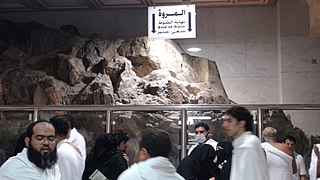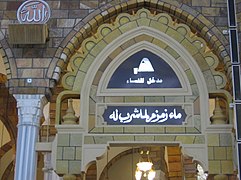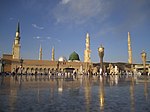Sacred Mosque
As of 2024, the Great Mosque is both the largest mosque in the world, and the most expensive building in the world. It has undergone major renovations and expansions through the years. It has passed through the control of various caliphs, sultans and kings, and is now under the control of the King of Saudi Arabia who is titled the Custodian of the Two Holy Mosques.
History
The Great Mosque contends with the Masjid As-Sahabah in the Eritrean city of Massawa and Quba Mosque in Medina as the oldest mosque. According to Islamic tradition, Islam as a religion precedes Muhammad, representing previous prophets such as Abraham. According to Islamic scholars, Abraham is seen as having built the Kaaba in Mecca, and consequently its sanctuary, which according to the Muslim view is seen as the first mosque that ever existed. According to other scholars, Islam started during the lifetime of Muhammad in the 7th century CE, and so did architectural components such as the mosque. In that case, either the Mosque of the Companions or Quba Mosque would be the first mosque that was built in the history of Islam.
Era of Abraham and Ismael
According to Islamic tradition in the Quran, Abraham, together with his son Ismael, raised the foundations of a house, which has been identified by commentators as the Kaaba. According to Islamic tradition, it is said that Allah showed Abraham the exact site, which was previously built by Adam, very near to what is now the Well of Zamzam. After Abraham had built the Kaaba, an angel is said to have brought him the Black Stone, a celestial stone that, according to tradition, had fallen from Heaven on the nearby hill Abu Qubays. The Black Stone is believed by Islamic scholars to be the only remnant of the original structure made by Abraham.
After placing the Black Stone in the Eastern corner of the Kaaba, Abraham reportedly received a revelation in which God told the aged prophet that he should now go and proclaim the pilgrimage to mankind, so that men may come both from Arabia and from lands far away, on camel and on foot.
Era of Muhammad
Upon Muhammad's victorious return to Mecca in 630 CE, Ali broke the idols in and around the Kaaba, similar to what, according to the Quran, Abraham did in his homeland. Thus ended polytheistic use of the Kaaba, and began monotheistic rule over it and its sanctuary.
Umayyad era
The first major renovation to the mosque took place in 692, on the orders of Abd al-Malik ibn Marwan. Before this renovation, which included the mosque's outer walls being raised , the mosque was a small open area with the Kaaba at the center. By the end of the 8th century, the mosque's old wooden columns had been replaced with marble columns and the wings of the prayer hall had been extended on both sides along with the addition of a minaret on the orders of Al-Walid I. The spread of Islam in the Middle East and the influx of pilgrims required an almost complete rebuilding of the site which included adding more marble and three more minarets.
Ottoman era
In 1570, Sultan Selim II commissioned the chief architect Mimar Sinan to renovate the mosque. This renovation resulted in the replacement of the flat roof with domes decorated with calligraphy internally, and the placement of new support columns which are acknowledged as the earliest architectural features of the present mosque. These features are the oldest surviving parts of the building.
During heavy rains and flash floods in 1621 and 1629, the walls of the Kaaba and the mosque suffered extensive damage. In 1629, during the reign of Sultan Murad IV, the mosque was renovated. In the renovation of the mosque, a new stone arcade was added, three more minarets (bringing the total to seven) were built, and the marble flooring was retiled. This was the unaltered state of the mosque for nearly three centuries.









